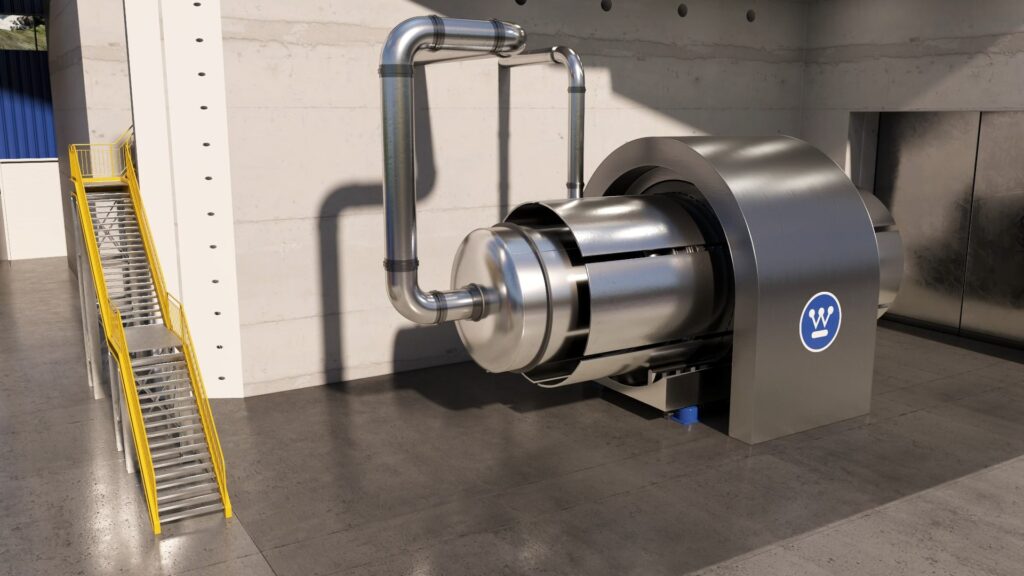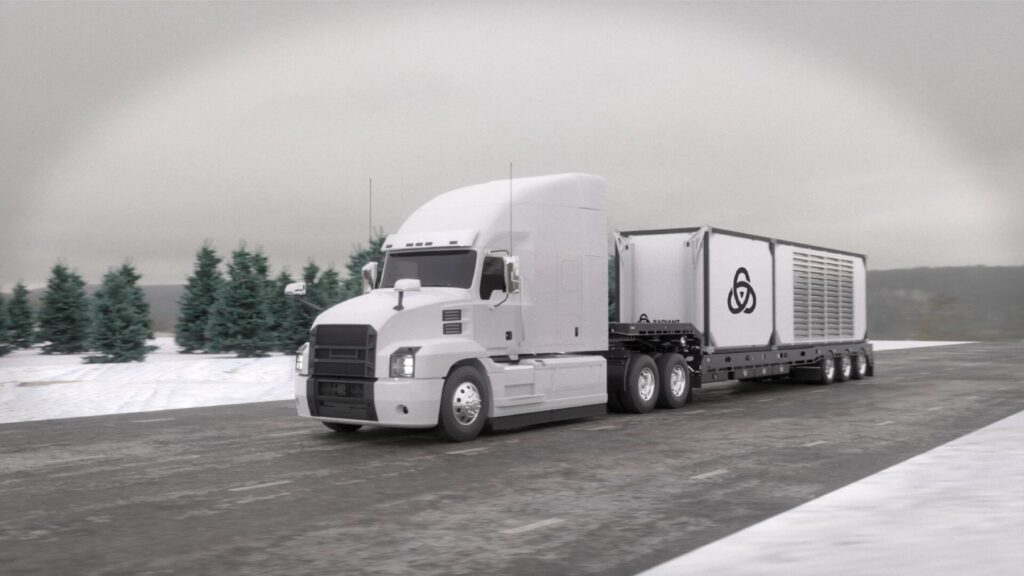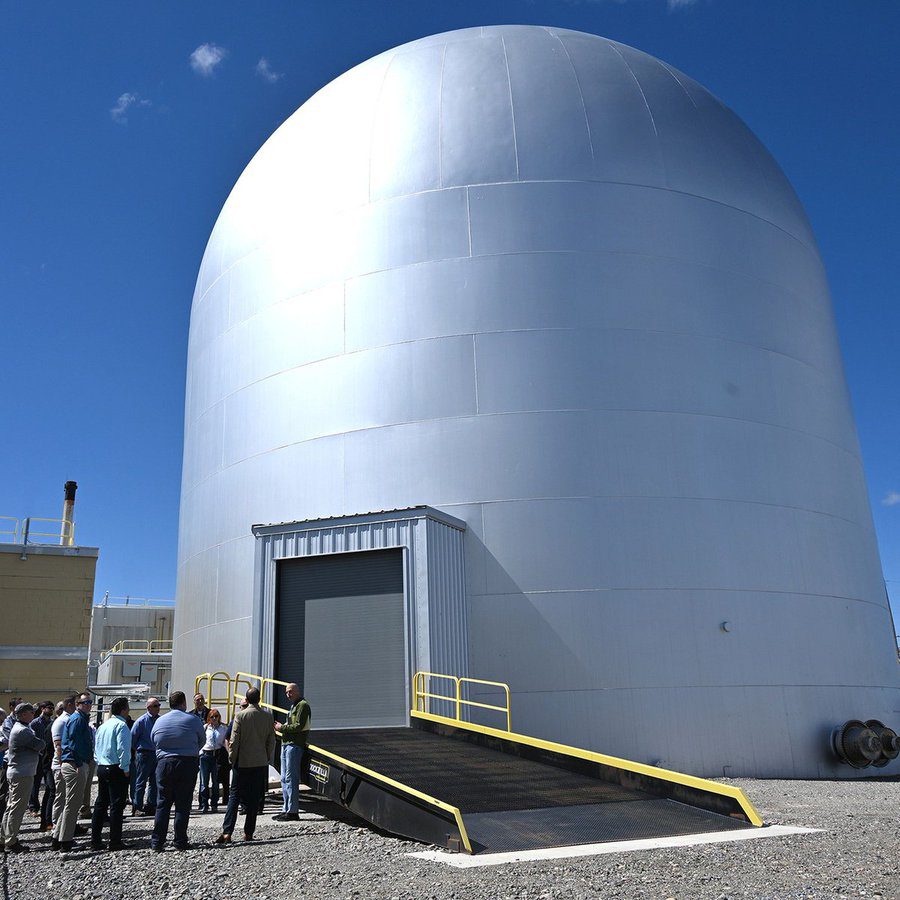DOE Picks Nuclear Designs for First Microreactor Experiments at INL’s New Test Bed
The Department of Energy (DOE) has unveiled three nuclear microreactor developers that will design the first experiments at Idaho National Laboratory’s (INL’s) new Demonstration of Microreactor Experiments (DOME) test bed, which repurposes the Experimental-Breeder Reactor-II (EBR-II) containment structure.
Westinghouse, Radiant Nuclear, and Ultra Safe Nuclear Corp. (USNC) will receive a combined $3.9 million to further their microreactor designs through a front-end engineering and experiment design (FEEED) process spearheaded by the National Reactor Innovation Center (NRIC), the DOE’s 2020-launched program designed to speed up demonstration and deployment of advanced nuclear energy.
“The FEEED process supports developers in planning for the design, fabrication, construction, and testing of fueled reactor experiments,” the DOE’s Office of Nuclear Energy said on Oct. 23. Testing at DOME could start “as early as 2026,” it noted.
An eVinci Nuclear Test Reactor
Westinghouse is poised to test its eVinci reactor (Figure 1), a portable microreactor concept of up to 5-MWe that it is readying for the market by 2027 and would be suited to decentralization” or resiliency applications. Westinghouse told POWER its test reactor will be “one-fifth scale representation” of an actual eVinci microreactor.

DOME “will enable design finalization, testing, and licensing of the technology utilizing INL’s National Reactor Innovation Center DOME test bed facility,” it said. During the FEEED contract phase, the eVinci team is slated to work with NRIC/INL to create an “End-to-End Reactor Test Program” plan and schedule for placing the test reactor in the INL facility, it noted.
Jon Ball, president for eVinci Technologies at Westinghouse, noted the opportunity marks a key pillar to support commercialization of Westinghouse’s flagship microreactor design. “We are at an inflection point and are accelerating the commercialization of our eVinci technology. NRIC’s partnership will be a critical enabler to advance technology readiness and licensing,” he said.
USNC Will Test Derivative of ’10-Ton-Class’ Pylon Microreactor
USNC will test Pylon D1, a derivative of its Pylon nuclear system architecture that the Seattle-based company is developing for research, transportable, and space applications. “As a 10-ton class microreactor, the Pylon architecture builds on Ultra Safe’s Micro-Modular Reactor (MMR) and Fully Ceramic Microencapsulated (FCM) [TRISO] fuel technologies to be more easily transportable and capable of safely generating electrical and thermal power anywhere,” Wesley Deason, Pylon Program manager at USNC, told POWER.
The Pylon D1 Demonstration System, slated for DOME testing, contains “a small HTGR that utilizes FCM nuclear fuel, metal hydride neutron moderator, and graphite control drums,” he noted. “Pylon D1 uses helium as the working fluid to transfer the fission generated heat from the reactor via the primary coolant loop to a secondary gas loop (helium, air, supercritical CO2, and other gases are currently under trade) for rejection into the surrounding environment.”
The test will allow USNC “to validate to our customers the promises of our technology including licensability, performance, operations, safety, and cost,” Deason added. “USNC’s strategy for enabling early demonstration relies on limiting scope to demonstrate only the Pylon D1 primary loop and by using commercially available 9.9% enriched uranium FCM TRISO fuel,” he noted.
But the demonstration may also have broader benefits, he suggested. “Demonstration will provide proof that USNC’s advanced nuclear technology—including additively manufactured FCM nuclear fuel and encapsulated solid metal hydride neutron moderators—can be safely incorporated within an operating 1-MWth nuclear reactor with 1000 K outlet temperatures,” he said. Enabling higher core temperatures and “an order of higher power density”—will serve to improve the performance of other USNC technologies, including the MMR, he suggested. That, in turn, willl support the development of future markets and attracting a “broader class of customers” to USNC, he said.
“The demonstration is focused solely on reaching reactor power and temperature goals, without the expense, design, and safety analysis complexity of a coupled power generation balance of plant,” Deason said. That’s why the opportunity to test on “significant infrastructure” is especially lucrative.”
The largest of these are items “such as the development of an entire confinement structure, a National Environmental Policy Act (NEPA) environmental assessment, and nuclear regulator interactions,” he said.
Radiant Poised to Test Kaleidos Battery
El Segundo, California–based Radiant Industries will test its Kaleidos Battery microreactor design (Figure 2), the DOE said. Radiant, a company founded in 2019 by former SpaceX engineers, has been developing a 1.2-MWe HTGR design, which will use TRISO fuel, a helium coolant, and a graphite moderator.
Kaleidos is a 1-MW nuclear genset, capable of replacing diesel gensets for prime power on remote microgrids or critical backup power, the company said. The company says the 1-MWe power generator, cooling system, reactor, and shielding are all packaged in a single shipping container, facilitating rapid deployment. “Essentially anywhere diesel is used today, we can do this by factory constructing and transporting to site, also bringing back the nuclear waste to handle at a centralized refueling facility.”
“We have proposed to test a full scale microreactor at 3.5MWt for 150 hours continuously,” Doug Bernauer Radiant CEO told POWER on Oct. 30. “The test will provide controlled conditions, well-trained staff, proximity to waste storage and test facilities including a hot cell that overall reduce the risk to test a first of a kind.” Bernauer said the test will produce data “with real rather than simulated fuel, and proof of operations of all safety critical components, allowing for reduced uncertainty in licensing for commercial units.”
Bernauer noted Radiant will enter pre-application with the NRC by the first quarter of 2024. “We are building prototype hardware now for subsystems, we intend to be able to deliver the first commercial unit in 2028. The site has not yet been selected,” he said.

DOME: A New Life for EBR-II
The DOE’s announcement on Monday marks the first awards under NRIC for the DOME test bed, effectively giving EBR-II—a sodium-cooled reactor that operated at INL from 1964 to 1994 (Figure 3)—new life as pivotal facility that could advance higher thermal power reactor projects.

While EBR-II was scheduled for demolition in 2019, INL in 2021 began refurbishing the facility to support programmatic research needs for its Materials and Fuels Complex (MFC). “While the reactor and much of its supporting equipment has been dismantled, the dome containment structure remains, providing a new opportunity for nuclear reactor demonstrations,” the DOE says. “Since EBR-II demonstrated electricity generation, the dome is well suited for higher thermal power reactor projects and those that aim to demonstrate electricity generation. As such, NRIC envisions to utilize the dome to host reactor demonstration and other nuclear projects.”
EBR II’s dome, about 80-feet in diameter and 45-feet tall, is built of a 1-inch-thick steel plating with a reinforced concrete inner structure. The DOE completed DOME’s design and awarded a construction contract in 2022. Over the past year, NRIC has focused on refurbishing the facility, adding new containment dome penetrations and modified equipment hatches, mechanical systems, a pump house, ventilations, and electrical systems. In 2024, NRIC expects to wrap up final preparations and reactor integration to ready for operations in 2026.
The DOME demonstration platform is “flexible enough” to test four to five small modular reactors, such as HTGRs, it says. It can host microreactors up to 20 MWth that use high-assay low-enriched uranium (HALEU) fuels, and it will allow “safety-significant confinement for reactors to go critical for the first time,” NRIC has said. The effort is intended to to “speed up microreactor development” while lessening “the environmental footprint, saving companies money in the testing process, and reducing overall project risk,” the agency noted.
The DOE is in tandem also developing the Laboratory for Operation and Testing in the U.S. (LOTUS), a separate test bed that will “host smaller reactor experiments to support the development of advanced reactors,” the DOE said. LOTUS will establish a Zero Physics Reactor (ZPRR) reactor cell as a Hazard Category 2 test bed with appropriate security controls to support testing of advanced reactor concepts (of up to 500 KWth) that use “highly enriched uranium and plutonium fuels.” Its first anticipated user may be the Molten Chloride Reactor Experiment (MCRE) being developed by Southern Co. and Terrapower.
INL is, meanwhile, making headway to startup MARVEL, its first new reactor in more than four decades. As POWER recently reported in an exclusive, the MARVEL microreactor in October 2023 achieved 90% final design, a key step that will allow the project to move forward with preparation for fabrication and construction. The DOE expects the 85-kWth (20-kWe) MARVEL reactor to help industry partners demonstrate microreactor applications, evaluate systems for remote monitoring, and develop autonomous control technologies for new reactors.
—Sonal Patel is a POWER senior associate editor (@sonalcpatel, @POWERmagazine).
Editor’s Note: Last update: Oct. 30, 2023, adds comments from Radiant.